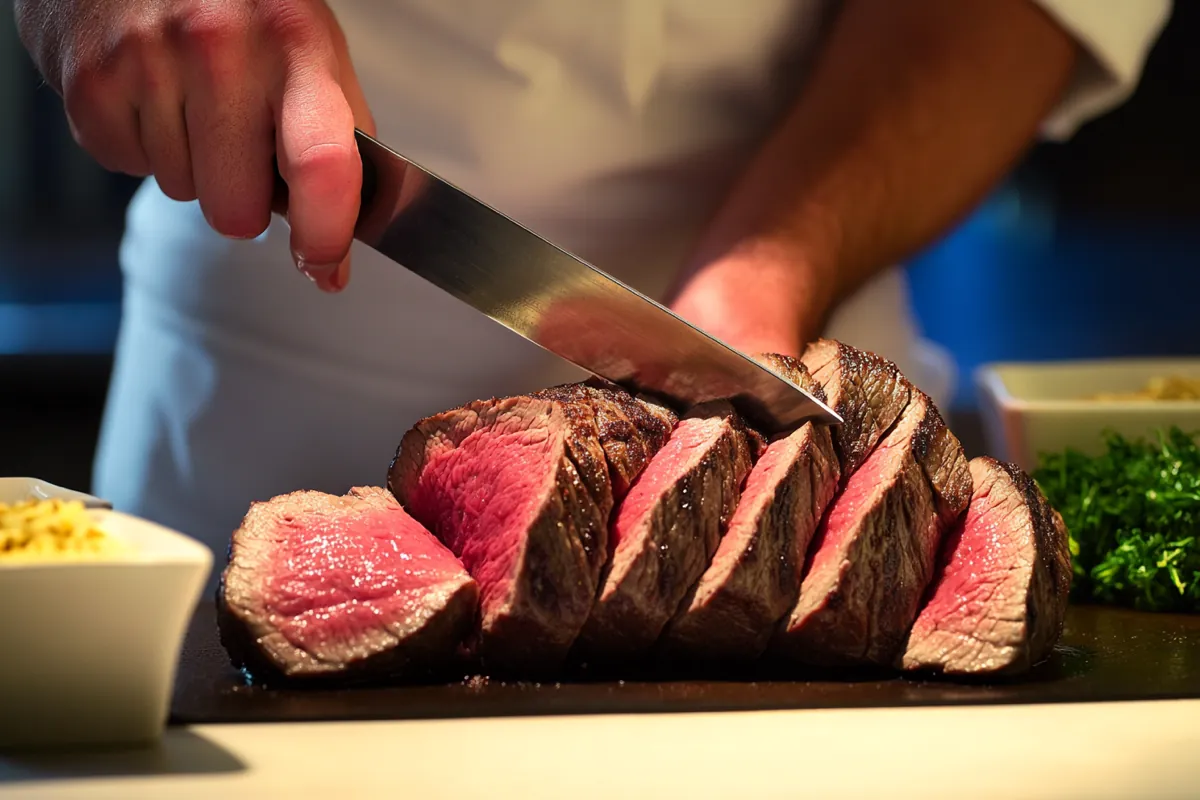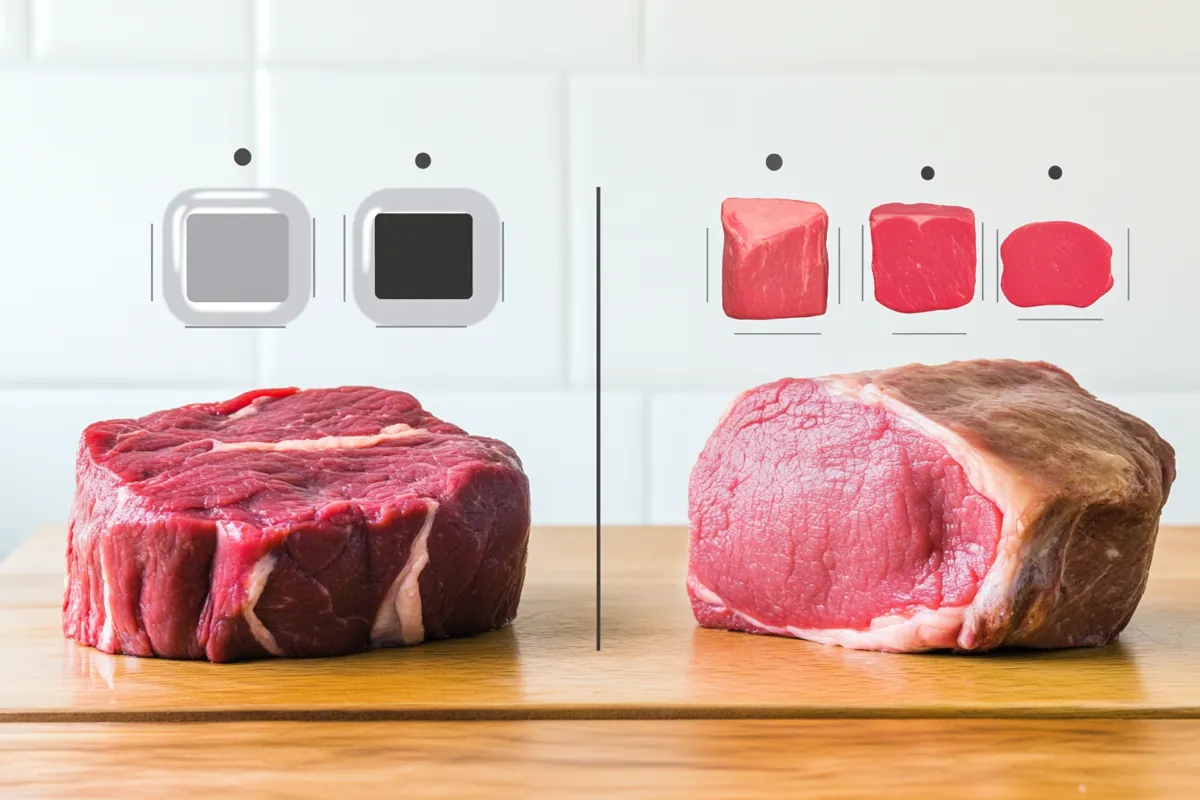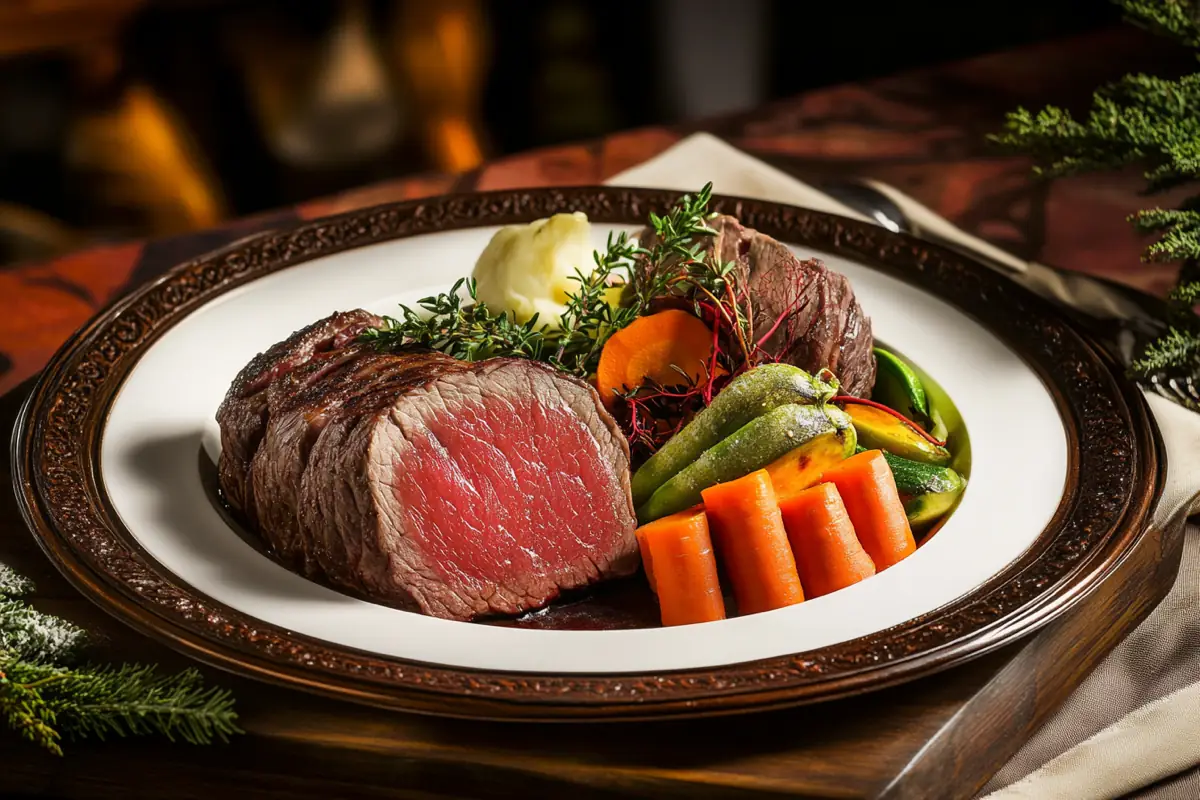When it comes to beef, two cuts often caught in culinary discussions are tenderloin and filet mignon. Many people wonder if the tenderloin same as filet mignon. In this guide, we will explore the truth behind this question, their unique characteristics, and how they compare in taste, preparation, and pricing. By the end, you will have a clearer understanding of these prized cuts of beef and their place in your kitchen.
Table of Contents
Understanding Tenderloin and Filet Mignon
To appreciate the differences and similarities between these cuts, it’s essential to understand what each one is and where they come from on the cow.
What is Tenderloin?
The tenderloin is a long, narrow cut of beef that runs along the spine of the cow. It is known for its exceptional tenderness, making it a favorite among steak lovers. This cut can be further divided into several portions, including the filet mignon, which is the most tender part. Given its location, the tenderloin gets very little exercise, resulting in a soft texture.
What is Filet Mignon?
Filet mignon is a specific cut taken from the tenderloin. It is usually cut into thick steaks and is highly prized for its buttery texture and mild flavor. Because it is such a small portion of the cow, filet mignon is often considered one of the most luxurious cuts available. Steaks from this area are typically about 1.5 to 2 inches thick, making for a delicious, impressive presentation when served.
Tenderloin Same as Filet Mignon: Key Differences
While the tenderloin and filet mignon may seem similar, there are key differences that set them apart.
Cut Location and Structure
The tenderloin is a larger cut that includes the filet mignon as one of its sections. The tenderloin runs along the spine and can weigh between 4 to 6 pounds. In contrast, filet mignon is just a small portion of the tenderloin, typically weighing around 6 to 8 ounces per steak. Thus, you can think of filet mignon as a premium portion of the tenderloin.
Culinary Uses and Preparation Methods
Both cuts are versatile, but they are often used in different culinary contexts. Tenderloin can be roasted whole, grilled, or cut into smaller steaks. It is great for various dishes, from elegant roasts to hearty steaks. On the other hand, filet mignon is often reserved for special occasions due to its tenderness and flavor. It is typically cooked using dry heat methods like grilling or pan-searing, allowing the natural flavors to shine through.
Tenderloin Same as Filet Mignon Taste: Flavor Profiles
When it comes to taste, both cuts have unique characteristics that will appeal to different palates.
Taste Comparison: Tenderloin vs. Filet Mignon
The tenderloin has a mild flavor profile, making it an excellent canvas for various seasonings and marinades. It is incredibly tender and juicy, but may not have as pronounced a beef flavor as some other cuts. In contrast, filet mignon is known for its buttery texture and richness. The marbling in filet mignon enhances its flavor, making it one of the most sought-after cuts for steak lovers.
Cooking Techniques that Influence Taste
How you prepare these cuts can significantly influence their taste. For instance, cooking filet mignon to a medium-rare temperature maximizes its juiciness and tenderness. On the other hand, tenderloin can benefit from longer cooking times, as this allows for flavor development and texture enhancement. Techniques like sous-vide can also be used for both cuts to achieve perfectly cooked results.
How Many Filet Mignon in a Cow?
Understanding how many filet mignon you can get from a cow provides insight into its value and rarity.
Beef Cuts and Yield from a Cow
Typically, a cow can produce several cuts of meat, but when it comes to filet mignon, the yield is relatively low. From one whole cow, you can expect to get around 2 to 4 tenderloins, depending on the size of the animal. Since filet mignon is derived from the tenderloin, this means you will have a limited number of filet mignon steaks available.

How Many Filet Mignon in a Tenderloin?
To truly appreciate the relationship between tenderloin and filet mignon, it’s important to understand how many filet mignon steaks can be obtained from a single tenderloin.
Understanding the Tenderloin Structure
As mentioned earlier, the tenderloin is a long, cylindrical muscle located along the spine of the cow. It can be divided into several sections, each of which can yield its own set of steaks. The tenderloin typically weighs between 4 to 6 pounds, and from this, you can derive several filet mignon steaks.
Generally, there are about 6 to 8 filet mignon steaks that can be cut from a single tenderloin, depending on the thickness of each cut. Most commonly, chefs and butchers slice the filet mignon into steaks that are approximately 1.5 to 2 inches thick.
Average Yield of Filet Mignon Cuts
Considering the average size of a tenderloin, if you manage to get 8 filet mignon steaks, each weighing around 6 to 8 ounces, you can imagine the premium nature of these cuts. Since filet mignon is highly sought after for its tenderness and flavor, this limited yield adds to its exclusivity and price in the market. Understanding this yield is crucial when planning meals or events that feature filet mignon, as it can affect your purchasing decisions.
Can You Cut a Beef Tenderloin into Filet Mignon?
If you have a whole beef tenderloin, you might wonder whether you can cut it into filet mignon steaks. The answer is yes!
Step-by-Step Cutting Instructions
Preparation: Begin by placing the tenderloin on a clean cutting board. Ensure that you have a sharp chef’s knife for clean cuts.
Trimming: Remove any silver skin (the tough membrane) from the tenderloin. This will help improve the texture and taste of your filet mignon.
Slicing: Starting from one end of the tenderloin, slice it into steaks. Aim for 1.5 to 2 inches in thickness for optimal cooking results.
Portioning: Continue slicing until you reach the end of the tenderloin. You should now have evenly cut filet mignon steaks.
Storing: If you’re not cooking them immediately, wrap the steaks tightly in plastic wrap and refrigerate or freeze them for later use.
Tips for Successfully Cutting Filet Mignon
Use a Sharp Knife: A sharp knife helps create clean cuts, which are essential for tender meat.
Chill the Tenderloin: If the tenderloin is slightly chilled, it will be easier to cut.
Practice: If you’re new to butchering, practice makes perfect. Don’t hesitate to watch tutorial videos or read guides to improve your technique.
By following these steps, you can easily create your own filet mignon steaks from a beef tenderloin, ensuring freshness and quality in every bite.
Are Tenderloin and Filet Mignon Interchangeable?
Now that we’ve explored how to cut tenderloin into filet mignon, let’s address whether these two cuts can be used interchangeably in recipes.
Culinary Perspectives on Substitution
In many culinary applications, tenderloin and filet mignon can be used interchangeably due to their similar texture. However, there are some important distinctions to consider. Since filet mignon is a specific cut from the tenderloin, it tends to be more tender and flavorful. As a result, if a recipe specifically calls for filet mignon, using the entire tenderloin may not yield the same results.
For instance, if you’re preparing a dish where the steak needs to be seared quickly, filet mignon would offer superior tenderness. On the other hand, if you’re making a stew or a dish that requires longer cooking times, using tenderloin is more than acceptable and can be quite delicious.
Texture and Flavor Considerations
While both cuts are tender, filet mignon’s texture is a notch above that of the whole tenderloin. The additional marbling in filet mignon contributes to its buttery flavor. When substituting tenderloin for filet mignon, keep in mind that the texture and flavor may vary slightly. Thus, if a recipe highlights the use of filet mignon for its unique characteristics, it’s best to stick with that cut for optimal results.

Cost Analysis: Is Beef Tenderloin More Expensive than Filet Mignon?
When it comes to purchasing beef, understanding the cost of various cuts is essential. This section will explore whether beef tenderloin is more expensive than filet mignon and the factors influencing these prices.
Pricing Trends for Tenderloin and Filet Mignon
Generally, filet mignon is more expensive than the whole tenderloin. This price discrepancy stems from the fact that filet mignon is a smaller, more desirable portion of the tenderloin. While prices can fluctuate based on location, season, and quality, you can typically expect filet mignon to command a premium price due to its reputation for tenderness and flavor.
For instance, as of recent market trends, filet mignon can range from $20 to $40 per pound, while tenderloin might be priced between $15 to $30 per pound. These figures can vary significantly based on quality grade (such as USDA Prime versus Choice) and whether the meat is sourced from specialty farms.
Factors Influencing Meat Prices
Several factors influence the pricing of beef cuts, including:
Supply and Demand: High demand for filet mignon, especially during holidays and special occasions, often drives prices up.
Quality of Meat: Higher quality meat, such as USDA Prime, will naturally cost more. The marbling and fat content significantly affect both tenderness and flavor.
Geographical Location: Prices can vary depending on where you purchase the meat. Urban areas may have higher prices compared to rural regions.
Butchering and Labor Costs: The skill involved in butchering can also impact the price. Cuts that require more labor, like filet mignon, may come with additional costs.
Understanding these factors can help you make informed purchasing decisions when shopping for beef.
Cooking Tips for Perfecting Tenderloin and Filet Mignon
Whether you’re preparing tenderloin or filet mignon, cooking techniques can greatly influence the final dish. Here are some tips to get the best results from these cuts.
Recommended Cooking Methods
Grilling: Both cuts are excellent when grilled. Ensure you preheat the grill and cook over high heat for a nice sear.
Pan-Searing: This method is ideal for filet mignon. Sear each side in a hot cast-iron skillet with a little oil until it’s golden brown, then finish in the oven for perfect doneness.
Sous-Vide: For the ultimate tenderness, sous-vide cooking allows you to cook meat slowly in a water bath at a precise temperature, ensuring the perfect texture.
Roasting: Whole tenderloin can be roasted in the oven. Use a meat thermometer to check for doneness and allow it to rest before slicing.
Seasoning and Marinades for Enhanced Flavor
While both cuts are flavorful on their own, seasoning or marinating can elevate their taste. Here are some ideas:
Simple Seasoning: Salt and pepper work wonders. Rub the cuts with salt and freshly cracked pepper before cooking for a delicious crust.
Garlic and Herbs: A marinade with garlic, rosemary, and thyme can add depth to the flavor. Let the meat sit in this mixture for at least an hour before cooking.
Butter Basting: For filet mignon, consider basting with butter during the last few minutes of cooking for an extra layer of richness.
By applying these techniques and tips, you can ensure that both tenderloin and filet mignon shine on your dinner table, impressing your guests and elevating your culinary skills.

Conclusion: Key Takeaways on Tenderloin and Filet Mignon
Understanding the relationship between tenderloin and filet mignon is essential for any meat lover. Throughout this article, we’ve explored their differences, similarities, cooking methods, and pricing.
Summary of Key Differences
- Cut Structure: Tenderloin is a larger cut that includes filet mignon as a portion.
- Flavor and Texture: Filet mignon is generally more tender and flavorful due to its marbling and smaller size.
- Cooking Methods: While both cuts can be grilled or roasted, filet mignon is often best cooked quickly to maintain its tenderness, whereas tenderloin can be used in a variety of dishes.
These distinctions are crucial for making informed decisions in the kitchen, whether you’re preparing a special meal or simply enjoying a delicious steak dinner.
Final Thoughts on Choosing Between the Two Cuts
When deciding between tenderloin and filet mignon, consider your cooking method and the occasion. If you’re looking for a luxurious dining experience, filet mignon is the way to go. However, if you’re hosting a gathering and want to serve multiple guests, a whole tenderloin provides versatility and can be more economical. Both cuts offer exceptional tenderness and flavor, making them fantastic additions to any meal.
Additional Resources and References
For further reading on beef cuts and cooking techniques, consider exploring these resources:
Recommended Reading on Beef Cuts
Links to Cooking Guides and Recipes
- Ultimate 3-Ingredient Steak Marinade Guide
- Calories in Filet Mignon Guide
- Horseradish Sauce for Beef Tenderloin Guide
Encouragement to Explore Cooking with Tenderloin and Filet Mignon
Now that you have a comprehensive understanding of tenderloin and filet mignon, we encourage you to experiment with these cuts in your kitchen. Whether you’re grilling, roasting, or trying out new marinades, both cuts can elevate your meals and impress your guests. Embrace the culinary adventure and savor the delightful flavors that these premium cuts of beef have to offer.
FAQ
As we wrap up this guide, let’s address some frequently asked questions regarding tenderloin and filet mignon.
What is the difference between tenderloin and filet mignon?
The main difference lies in the location and size. The tenderloin is a larger cut that includes the filet mignon, which is a smaller, more tender steak cut from the tenderloin.
Can you substitute tenderloin for filet mignon in recipes?
Yes, you can substitute tenderloin for filet mignon, but keep in mind that the texture and flavor may differ slightly. Filet mignon is generally more tender and flavorful.
Are tenderloin and filet mignon interchangeable?
In many cases, they can be used interchangeably, especially in recipes that call for quick cooking methods. However, for dishes that highlight the unique characteristics of filet mignon, it is important to note that filet mignon is cut from the smaller end of the tenderloin and is known for its exceptional tenderness and delicate flavor. While tenderloin encompasses the whole muscle, including both the larger and smaller ends, filet mignon refers specifically to the most prized and tender portion.




